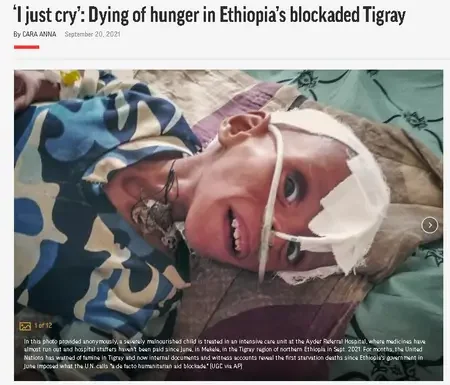September 24, 2021
Photo provided “anonymously”
This heartbreaking photo of a starving child said to be at Ayder Referral Hospital in Mekelle, Tigray was provided “anonymously” according to t
e notes on the photo, used in a recent article published in the Associated Press. It appears to be acquired at a time when the Ethiopian federal government no longer controls Mekelle.
 From a journalistic standards standpoint, usually if we are talking to hospital officials for a story, we would get a photo sourced directly from the hospital, unless there are special circumstances. For example, if say the Ethiopian federal government was still in control of Mekelle and hospital officials feared retribution, then you would consider an anonymous source for such a heart-wrenching and consequential picture.
From a journalistic standards standpoint, usually if we are talking to hospital officials for a story, we would get a photo sourced directly from the hospital, unless there are special circumstances. For example, if say the Ethiopian federal government was still in control of Mekelle and hospital officials feared retribution, then you would consider an anonymous source for such a heart-wrenching and consequential picture.
The Ethiopian government no longer controls Mekelle. The Associated Press itself reported in late June that the Ethiopian government “declared an immediate, unilateral cease-fire’ and left Mekelle and Tigray forces occupied it. Because of the gravity of this photo and the allegations from both sides of the conflict that hunger is being weaponized, it’s worth asking, who and where did this photo come from?
Ayder Hospital, a federal institution
Per article, at Ayder Referral Hospital in Mekelle, Tigray “… medicines have run out and hospital staffers haven’t been paid since June.” Ayder Referral Hospital is a federal institution and therefore funded by the federal government of Ethiopia. In June, Tigray forces came into and occupied Mekelle in what the New York Times reported as “Tigray forces in Ethiopia celebrate a victory.” The Ethiopian government declared a unilateral ceasefire and left the city. With that went funding for critical institutions like Ayder Hospital. The Ethiopian government no longer has access to Mekelle.
Allegations of Govt “Humanitarian aid Blockade”
It is widely reported including in this article that “Ethiopia’s government in June imposed what the U.N. calls “a de facto humanitarian aid blockade,” but there appear to be indications that aid is in fact reaching Tigray, although likely much more is needed in the region. On Sept 5, UN World Food Programme Ethiopia reported WFP-led convoy of over 100 trucks into Mekelle.
The above AP report quotes the UN saying “.. as of Sept 8, fewer than 500 [aid trucks] had arrived [in Tigray] since July.” But doesn’t mention that UN Ethiopia recently said most of those trucks never came back. Of the 466 aid trucks that went into Tigray since July 12, only 38 returned, says UN Ethiopia adding “We need trucks to deliver lifesaving assistance to people in Tigray.” Neither side of the conflict deny that these aid trucks reached Tigray. The explanation of why they didn’t return differs.
Tigray regional leadership says this is due to shortage of fuel. Ethiopian government says they suspect “TPLF seizing trucks for own logistics.” WFP spokeswoman Gemma Snowdon recently said the missing trucks are “the primary impediment to moving humanitarian aid into Tigray.” Snowdon added WFP has no information about where the trucks are or what they are being used for.

















